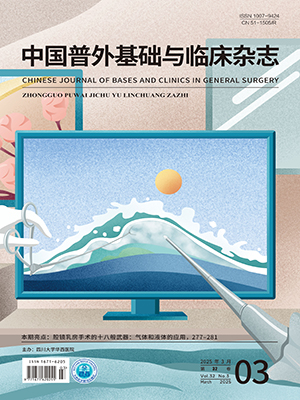Objective To observe the expression of GdCl3 on Toll-like receptors (TLRs) of RAW264.7 from murine macrophage cell line induced by lipopolysaccharide (LPS) stimulation. Methods Cells were divided into 3 groups: blank group, LPS group and GdCl3 group. And these cells dyed by goat anti-mouse TLR2/4 poly-antibody and anti-goat IgG labelled with fluorescein isothiocyanate (FITC). The synthesis of TLR2/4 protein were determined by flow cytometry (FCM) analysis and reverse transcription polymerase chain reaction (RT-PCR) analyzed their gene expression. Cell supernatants were taken to measure TNF-α production following the ELISA (enzyme-linked immunosorbent assay) protocol. Results The expressions of TLR2/4 protein and mRNA in GdCl3 group under action of different concentration of GdCl3〔TLR2/4 protein, 200 μmol/L: (70.2±1.28)%/(66.7±2.59)%, 400 μmol/L: (64.9±1.43)%/(60.4±1.25)%, 2 000 μmol/L: (47.4±0.98)%/(32.1±0.74)%; TLR2/4 mRNA (the value of absorbance), 200 μmol/L: (76.42±2.76)/(101.72±3.14), 400 μmol/L: (75.60±3.76)/(89.65±5.17), 2 000 μmol/L: (64.22±4.67)/(78.44±4.88)〕 were significantly lower than those of in LPS group 〔TLR2/4 protein: (94.4±1.76)%/(95.7±0.87)%, P<0.01; TLR2/4 mRNA: (127.64±3.25)/(119.82±5.59), P<0.05, P<0.01〕. The expression of TNF-α in GdCl3 group under action of different concentration of GdCl3〔200 μmol/L: (2 540±77) pg/ml, 400 μmol/L: (2 041±106) pg/ml, 2 000 μmol/L: (1 020±220) pg/ml〕 was also significantly lower that that of in LPS group 〔(4 688±127) pg/ml, P<0.01)〕. Conclusion GdCl3 significantly inhibits TLR expression and secretion of TNF-α under the condition of LPS stimulation in vivo.
Citation:
XU Jianbo,WU Heshui,ZHANG Jinxiang,WANG Lin,JIN Qinwen,TIAN Yuan,ZHANG Jinghui,ZHANG Lei.. Impact of GdCl3 on Toll-Like Receptors Expression Induced by Lipopolysaccharide in Murine Macrophage Cell Line RAW264.7. CHINESE JOURNAL OF BASES AND CLINICS IN GENERAL SURGERY, 2006, 13(6): 681-684. doi:
Copy
Copyright © the editorial department of CHINESE JOURNAL OF BASES AND CLINICS IN GENERAL SURGERY of West China Medical Publisher. All rights reserved
| 1. |
Akira S, Sato S. Toll-like receptors and their signaling mechanisms [J]. Scand J Infect Dis, 2003; 35(9)∶ 555.
|
| 2. |
Wu HS, Zhang JX, Wang L, et al. Toll-like receptor 4 inv-olvement in hepatic ischemia/reperfusion injury in mice [J]. Hepatobiliary Pancreat Dis Int, 2004; 3(2)∶250.
|
| 3. |
Medzhitov R. Toll-like receptors and innate immunity [J]. Nat Rev Immunol, 2001; 1(2)∶135.
|
| 4. |
Schauer RJ, Bilzer M, Kalmuk S, et al. Microcirculatory failure after rat liver transplantation is related to Kupffer cell-derived oxidant stress but not involved in early graft dysfunction [J]. Transplantation, 2001; 72(10)∶1692.
|
| 5. |
Shibuya H, Ohkohchi N, Seya K, et al. Kupffer cells generate superoxide anions and modulate reperfusion injury in rat livers after cold preservation [J]. Hepatology, 1997; 25(2)∶35.
|
| 6. |
Dekai Zhang, Guolong Zhang, Matthew S, et al. A toll-like receptor that prevents infection by uropathogenic bacteria[J]. Science, 2004; 303(5633)∶1522.
|
| 7. |
Aliprantis AO, Yang RB, Mark MR, et al. Cell activation and apoptosis by bacterial lipoproteins through toll-like receptor-2 [J]. Science, 1999; 285 (5428)∶736.
|
| 8. |
吴河水, 王 峰, 王 琳, 等. 小鼠肝缺血/再灌注损伤时肝脏Kupffer细胞中TLR2的表达 [J]. 中国普通外科杂志, 2004; 13(8)∶591.
|
| 9. |
Musikacharoen T, Matsuguchi T, Kikuchi T, et al. NF-kappa B and STAT5 play important roles in the regulation of mouse Toll-like receptor 2 gene expression [J]. J Immunol, 2001; 166(7)∶4516.
|
| 10. |
Muzio M, Polntarutti N, Bosisio D, et al. Toll like receptor family (TLT) and signalling pathway [J]. Eur Cytokine Netw, 2000; 11(3)∶489.
|
| 11. |
Lee CM, Yeoh GC, Olynyk JK. Differential effects of gadolinium chloride on Kupffer cells in vivo and in vitro [J]. Int J Biochem Cell Biol, 2004; 36(3)∶481.
|
- 1. Akira S, Sato S. Toll-like receptors and their signaling mechanisms [J]. Scand J Infect Dis, 2003; 35(9)∶ 555.
- 2. Wu HS, Zhang JX, Wang L, et al. Toll-like receptor 4 inv-olvement in hepatic ischemia/reperfusion injury in mice [J]. Hepatobiliary Pancreat Dis Int, 2004; 3(2)∶250.
- 3. Medzhitov R. Toll-like receptors and innate immunity [J]. Nat Rev Immunol, 2001; 1(2)∶135.
- 4. Schauer RJ, Bilzer M, Kalmuk S, et al. Microcirculatory failure after rat liver transplantation is related to Kupffer cell-derived oxidant stress but not involved in early graft dysfunction [J]. Transplantation, 2001; 72(10)∶1692.
- 5. Shibuya H, Ohkohchi N, Seya K, et al. Kupffer cells generate superoxide anions and modulate reperfusion injury in rat livers after cold preservation [J]. Hepatology, 1997; 25(2)∶35.
- 6. Dekai Zhang, Guolong Zhang, Matthew S, et al. A toll-like receptor that prevents infection by uropathogenic bacteria[J]. Science, 2004; 303(5633)∶1522.
- 7. Aliprantis AO, Yang RB, Mark MR, et al. Cell activation and apoptosis by bacterial lipoproteins through toll-like receptor-2 [J]. Science, 1999; 285 (5428)∶736.
- 8. 吴河水, 王 峰, 王 琳, 等. 小鼠肝缺血/再灌注损伤时肝脏Kupffer细胞中TLR2的表达 [J]. 中国普通外科杂志, 2004; 13(8)∶591.
- 9. Musikacharoen T, Matsuguchi T, Kikuchi T, et al. NF-kappa B and STAT5 play important roles in the regulation of mouse Toll-like receptor 2 gene expression [J]. J Immunol, 2001; 166(7)∶4516.
- 10. Muzio M, Polntarutti N, Bosisio D, et al. Toll like receptor family (TLT) and signalling pathway [J]. Eur Cytokine Netw, 2000; 11(3)∶489.
- 11. Lee CM, Yeoh GC, Olynyk JK. Differential effects of gadolinium chloride on Kupffer cells in vivo and in vitro [J]. Int J Biochem Cell Biol, 2004; 36(3)∶481.




